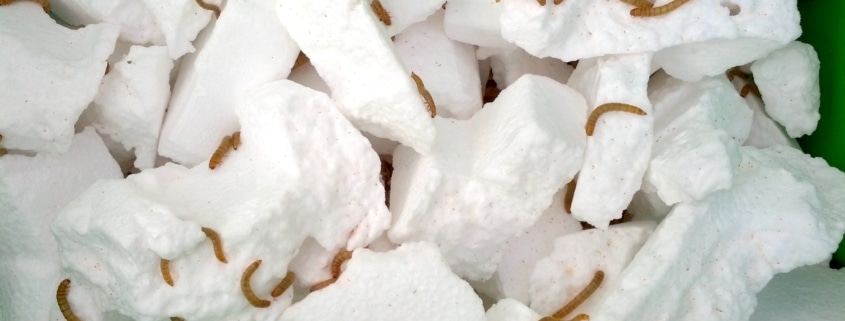
From plastic to protein – insects as new solution pathways
Background: Protein supply with an expanding world population
Protein plays an important role in covering the macro- and micronutrient deficiencies of the world population. With the increasing prosperity, as well as the price reduction due to factory farming, the consumption of meat also increased. At the same time, industrial livestock production is one of the biggest factors in local and global environmental problems.1 It is predicted that there will be an increase in the average annual demand for protein, from 37.4 kg per person in 2000 to 52 kg per person in 2050.2 This represents an enormous growth, especially considering that in 2050 there will probably be more than 9,7 billion people living on our planet.3
In order to meet the demand for protein, the supply of meat and vegetable proteins would have to be drastically increased. However, this would exacerbate environmental problems and miss any climate targets. On the one hand, both protein sources use large areas of land in monocultures, resulting in a low diversity rates and often cut-clearing rainforests. Second, meat production is a driver of climate change due to high methane emissions, especially from cattle. Water and food consumption are also not environmentally friendly, not to mention the ethical problems of factory farming. In addition, there are health concerns as antibiotics are widely used in factory farming, which in turn can lead to resistant germs.
However, there is still an alternative source of protein that is already used in many parts of the world, but in this country is still strongly stigmatized. We are talking about insects.
Innovation: From plastic to protein
About a third of the world’s population regularly eats insects, but they are still largely rejected, especially in Western society. Yet, they could contribute to a stable and more environmentally friendly food supply. Insects have a protein content of up to 77% in dry matter.4 In addition, they are rich in many different nutrients, including important fatty acids that are otherwise consumed mainly through fish.
In animal feed, insect meals could replace 25 to 100 percent of soy or fish meal requirements, depending on the species. Some insect species that can be used as food require only simple organic byproducts or waste for rearing. These facts are particularly interesting because about 1.3 billion tons of organic waste are produced annually.4 Depending on space requirements and protein efficiency, insects are also much more efficient than other animal protein sources. Therefore, they can be used as animal feed as well as human food. Unlike other animal food sources, insects also do not compete for land use with food and crop plants. They use only 1/10 of the land area compared to pigs and cattle, emit only 1/100 of the greenhouse gases, and have a much higher conversion rate, as well as a higher edible content.5 Additionally, they require twelve times less feed than cattle for the same amount of meat, which also conserves resources.
But insects can help out in more than just the food supply. Scientists at Beihang University in Beijing and Stanford University in California discovered that there are certain types of bacteria in the gut of waxworms (Plodia interpunctella) and mealworms (Tenebrio molitor) that enable the consumption of polystyrene foam.6 Polystyrene is a common type of plastic that accounts for 7 percent of the annual global plastic production of about 46.3 million tons.7 This creates the opportunity to grow mealworms while eliminating polystyrene waste in protein production.8 Waxworms, the larvae of the Indian meal moth, are also able to chew and eat PE films. In their paper, the scientists describe that the polystyrene eaten by the mealworms is converted into 47.7% CO2, 49.2% fecal matter and 0.5% biomass. That means that 1 kg of mealworms can be obtained from 200 kg of polystyrene. This is possible due to two strains of bacteria (Enterobacter asburiae YT1 and Bacillus YP1) isolated in their intestines.9 Through several chemical and biological test procedures, it was proven that mealworms can decompose and degrade polystyrene.
By analyzing the molecular weight in the fecal extract of the worms, it was proven that depolymerization/splitting of the long-chain polystyrene structure occurred and new fragments with a lower molecular weight were formed in the mealworms’ intestines.5 BE Solutions conducted a series of tests in this regard. Our test breeding proved that mealworms do indeed consume PS. We gave them different types of PS and observed a difference in the duration of PS consumption. While 1 g of a certain type of PS was consumed by about 60 g mealworms in less than 4 hours, it took 4 days or even longer for other types of PS. Approximately 12.4g of mealworms ate 0.2g of PS in 1.45 hours.
Potential: Combined and decentralized systems
In the next step, researchers would like to study the intestinal bacteria of mealworm larvae and examine the extent to which they can be multiplied after extraction and used in degradation processes in industry, in landfills or in sewage treatment plants. According to the scientists, the mealworms’ effect is not limited to the biological degradation of plastics, because the larvae convert the polystyrene into biomass for their own organism. The mealworms can then be reused as high-quality fish food, for example, since, as described above, they are high-quality sources of protein. In this way, cycles can be closed and two problems (plastic reduction and food shortage) can be addressed at the same time. In such a loop system we see special potential in the use for a decentralized solution of plastic disposal and safe food supply, especially in financially and infrastructurally weak areas.
In addition, there is another potential. Insects have a fairly high fat content. Certain species can be used to produce oils and, above all, a fat similar to palm oil. In view of the major problems concerning forest clearing and monocultures for the production of palm oil, insects could offer a further solution.
This might interest you: Tasty multi-talent: fungi!
References:
1 https://www.sciencedirect.com/science/article/abs/pii/S0924224412001458
2 http://www.fao.org/global-perspectives-studies/en/
3 https://www.un.org/development/desa/en/news/population/world-population-prospects-2019.html
4 https://www.madr.ro/docs/ind-alimentara/risipa_alimentara/presentation_food_waste.pdf
5 https://pubs.acs.org/doi/10.1021/acs.est.5b02661
7 https://pubs.acs.org/doi/10.1021/acs.est.5b02661
8 https://pubs.acs.org/doi/10.1021/es504038a
9 https://www.sciencedirect.com/science/article/abs/pii/096517489400048M



